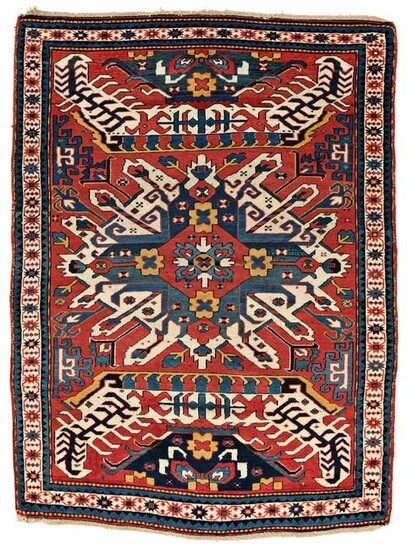Sunburst Eagle Kazak (Chelaberd) Rug
Sunburst Eagle Kazak (Chelaberd)
201 x 150 cm (6' 7" x 4' 11")
Caucasus, ca. 1880
Condition: very good, scattered low pile, scattered small reweavings, selvages partially rebound
Warp: wool, weft: wool, pile: wool
One would not be surprised if the term 'Eagle Kazak' was first coined in a German-speaking country as the design resembles the eagle on the German coat of arms, especially the version used between 1888 and 1918. Nevertheless, it has been long established that the design originates from 17th/18th century northwest Persian blossom carpets. In the later pieces, just the central 'Sunburst' design is repeated on the carpets. This example with the curved leaf designs above and below the centre relate the rug to the dragon and blossom carpets of Azerbaijan. These leaves surrounded a more complex design on the large and long earlier carpets. A famous example showing the same designs, now in the Met in New York, is published as plate 42 in McMullan, Islamic Carpets. The Wher/Zaleski carpet, published in Stars of the Caucasus (p.24), shows how directly the leaf designs have been taken across. Possibly due to being so instantly recognisable, this type of carpet is a staple in many collections. The earlier, in design development but not necessarily in age, form with a single medallion and leaf has always been the more desirable.
An almost identical rug was published by Krikor Markarian in HALI 160 (p.93) with an Armenian inscription dated 1854.
View it on
Sale price
Estimate
Time, Location
Auction House
Sunburst Eagle Kazak (Chelaberd)
201 x 150 cm (6' 7" x 4' 11")
Caucasus, ca. 1880
Condition: very good, scattered low pile, scattered small reweavings, selvages partially rebound
Warp: wool, weft: wool, pile: wool
One would not be surprised if the term 'Eagle Kazak' was first coined in a German-speaking country as the design resembles the eagle on the German coat of arms, especially the version used between 1888 and 1918. Nevertheless, it has been long established that the design originates from 17th/18th century northwest Persian blossom carpets. In the later pieces, just the central 'Sunburst' design is repeated on the carpets. This example with the curved leaf designs above and below the centre relate the rug to the dragon and blossom carpets of Azerbaijan. These leaves surrounded a more complex design on the large and long earlier carpets. A famous example showing the same designs, now in the Met in New York, is published as plate 42 in McMullan, Islamic Carpets. The Wher/Zaleski carpet, published in Stars of the Caucasus (p.24), shows how directly the leaf designs have been taken across. Possibly due to being so instantly recognisable, this type of carpet is a staple in many collections. The earlier, in design development but not necessarily in age, form with a single medallion and leaf has always been the more desirable.
An almost identical rug was published by Krikor Markarian in HALI 160 (p.93) with an Armenian inscription dated 1854.



